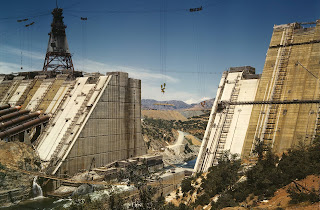Dams Construction
Early dam building took place in Mesopotamia and the Middle East. Dams were used to control the water level, for Mesopotamia's weather affected the Tigris and Euphrates rivers.
The earliest known dam is the Jawa Dam in Jordan, 100 kilometres (62 mi) northeast of the capital Amman. This gravity dam featured an originally 9-metre-high (30 ft) and 1 m-wide (3.3 ft) stone wall, supported by a 50 m-wide (160 ft) earth rampart. The structure is dated to 3000 BC.
The Ancient Egyptian Sadd-el-Kafara Dam at Wadi Al-Garawi, located about 25 km (16 mi) south of Cairo, was 102 m (335 ft) long at its base and 87 m (285 ft) wide. The structure was built around 2800 or 2600 BC as a diversion dam for flood control, but was destroyed by heavy rain during construction or shortly afterwards. During the Twelfth Dynasty in the 19th century BC, the Pharaohs Senosert III, Amenemhat III and Amenemhat IV dug a canal 16 km (9.9 mi) long linking the Fayum Depression to the Nile in Middle Egypt. Two dams called Ha-Uar running east-west were built to retain water during the annual flood and then release it to surrounding lands. The lake called "Mer-wer" or Lake Moeris covered 1,700 km2 (660 sq mi) and is known today as Berkat Qaroun.
By the mid-late third millennium BC, an intricate water-management system within Dholavira in modern-day India was built. The system included 16 reservoirs, dams and various channels for collecting water and storing it.
The earliest known dam is the Jawa Dam in Jordan, 100 kilometres (62 mi) northeast of the capital Amman. This gravity dam featured an originally 9-metre-high (30 ft) and 1 m-wide (3.3 ft) stone wall, supported by a 50 m-wide (160 ft) earth rampart. The structure is dated to 3000 BC.
The Ancient Egyptian Sadd-el-Kafara Dam at Wadi Al-Garawi, located about 25 km (16 mi) south of Cairo, was 102 m (335 ft) long at its base and 87 m (285 ft) wide. The structure was built around 2800 or 2600 BC as a diversion dam for flood control, but was destroyed by heavy rain during construction or shortly afterwards. During the Twelfth Dynasty in the 19th century BC, the Pharaohs Senosert III, Amenemhat III and Amenemhat IV dug a canal 16 km (9.9 mi) long linking the Fayum Depression to the Nile in Middle Egypt. Two dams called Ha-Uar running east-west were built to retain water during the annual flood and then release it to surrounding lands. The lake called "Mer-wer" or Lake Moeris covered 1,700 km2 (660 sq mi) and is known today as Berkat Qaroun.
By the mid-late third millennium BC, an intricate water-management system within Dholavira in modern-day India was built. The system included 16 reservoirs, dams and various channels for collecting water and storing it.
One of the engineering wonders of the ancient world was the Great Dam of Marib in Yemen. Initiated somewhere between 1750 and 1700 BC, it was made of packed earth – triangular in cross section, 580 m (1,900 ft) in length and originally 4 m (13 ft) high – running between two groups of rocks on either side, to which it was linked by substantial stonework. Repairs were carried out during various periods, most important around 750 BC, and 250 years later the dam height was increased to 7 m (23 ft).
After the end of the Kingdom of Saba, the dam fell under the control of the Ḥimyarites (~115 BC) who undertook further improvements, creating a structure 14 m (46 ft) high, with five spillway channels, two masonry-reinforced sluices, a settling pond, and a 1,000 m (3,300 ft) canal to a distribution tank. These extensive works were not actually finalized until 325 AD and allowed the irrigation of 25,000 acres (100 km2). More details

